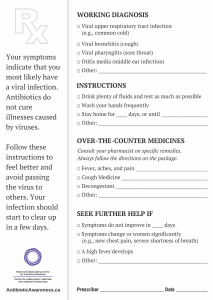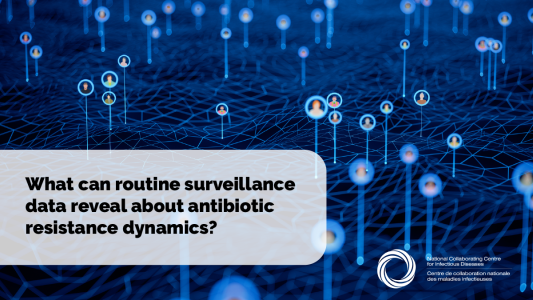
Antimicrobial resistance (AMR) refers to changes in infectious organisms (viruses, bacteria, fungi and parasites) so that they can no longer be controlled or treated effectively by standard drugs such as antibiotics, antivirals and antifungals.
AMR is an increasingly serious threat to public health and NCCID is working with partners across the country to provide evidence and resources on AMR surveillance and antimicrobial use (AMU).
Antibiotic Awareness Week
Unnecessary use and misuse of antibiotics and other antimicrobials is increasing the serious problem of antimicrobial resistance (AMR) in Canada and around the world. Resistant microbes make infections much harder or impossible to treat. Antimicrobial Awareness Week (formerly Antibiotic Awareness Week), held November 18 – 24 every year, promotes informed, careful use of these life-saving medicines to help keep them working for future generations.
What’s New
CAN AMS! Building an Antimicrobial Stewardship Committee in Long-term Care
This webinar discusses the experiences of two long-term care facilities in Saskatchewan who were each tasked with developing an antimicrobial stewardship committee.
CAN AMS! Three Can-Do Outlooks on AMS
Join this engaging session highlighting opportunities for antimicrobial stewardship (AMS) in human, animal, and environmental health domains. NCCID and AMMI Canada welcome leaders in AMS from across Canada for this launch of the ‘CANAMS!’ series.
Infographic: Methicillin-resistant Staphylococcus aureas (MRSA)
This infogrpahic overviews the resistant bacteria, Methicillin-resistant Staphylococcus aureas (MRSA). It answers questions about symptoms, treatment and prevention.
Fact Sheet: MRSA in Correctional Facilities and Shelters
This fact sheet overviews the resistant bacteria, Methicillin-resistant Staphylococcus aureas (MRSA). MRSA is commonly associated with hospital settings (called health-care associated MRSA or HA-MRSA).
What can routine surveillance data reveal about antibiotic resistance dynamics?
This webinar will address two analyses of routine surveillance data designed to support parameterisation and construction of mechanistic mathematical models of AMR.
Drug Resistant Infections: More Than Meets the Eye
The story is a relatable patient journey through the eyes of a caregiver, with suggestions on what patients can do to self- advocate and partner with healthcare providers to slow the emergence and control the spread of AMR.
Resources
Viral Prescription Pads
Provides information about symptomatic relief for infections and indicates when patients should consider a return visit. To be used with patients (adults and children) who have a suspected viral infection.
Download below or order free copies of prescription pads, here.

Surveillance of Antimicrobial Resistance and Antimicrobial Utilization in Canada
REPORT
There have been important expansions within existing national surveillance programs (Canadian Nosocomial Infection Surveillance Program and the Canadian Integrated Program for AMR Surveillance), with new data integration and reporting by the Canadian AMR Surveillance System. However, important gaps in the AMR/AMU surveillance “patchwork” in Canada must be addressed to make it a comprehensive, integrated, One Health program.
Our review highlights 3 crucial areas for action:
- development of a complete, integrated AMR/AMU surveillance program that builds on current success;
- changes in federal-provincial-territorial policies to compel standardized AMR/AMU reporting; and
- investment in AMR/AMU surveillance resources (dedicated personnel, funding, and enabling structures and policy).
Notable Publications
Events
CAN AMS! Building an Antimicrobial Stewardship Committee in Long-term Care
This webinar discusses the experiences of two long-term care facilities in Saskatchewan who were each tasked with developing an antimicrobial stewardship committee.
CAN AMS! Three Can-Do Outlooks on AMS
Join this engaging session highlighting opportunities for antimicrobial stewardship (AMS) in human, animal, and environmental health domains. NCCID and AMMI Canada welcome leaders in AMS from across Canada for this launch of the ‘CANAMS!’ series.
Infographic: Methicillin-resistant Staphylococcus aureas (MRSA)
This infogrpahic overviews the resistant bacteria, Methicillin-resistant Staphylococcus aureas (MRSA). It answers questions about symptoms, treatment and prevention.
Fact Sheet: MRSA in Correctional Facilities and Shelters
This fact sheet overviews the resistant bacteria, Methicillin-resistant Staphylococcus aureas (MRSA). MRSA is commonly associated with hospital settings (called health-care associated MRSA or HA-MRSA).
What can routine surveillance data reveal about antibiotic resistance dynamics?
This webinar will address two analyses of routine surveillance data designed to support parameterisation and construction of mechanistic mathematical models of AMR.
Drug Resistant Infections: More Than Meets the Eye
The story is a relatable patient journey through the eyes of a caregiver, with suggestions on what patients can do to self- advocate and partner with healthcare providers to slow the emergence and control the spread of AMR.





